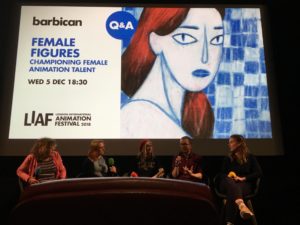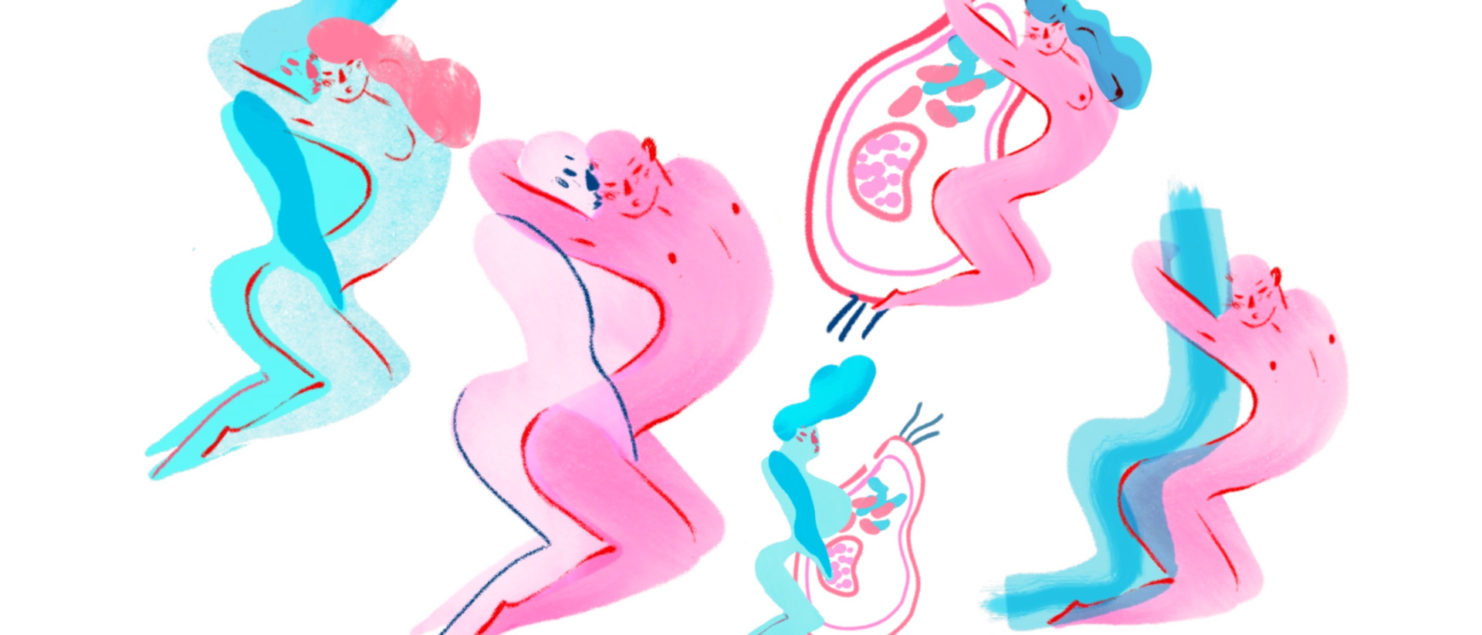Female Figures 2018 – introduction
 After having hosted another invigorating Female Figures screening and panel discussion at London International Animation Festival, joined by my brilliant guests Jenny Jokela, Jez Stewart, Kate Jessop and Thalma Goldman Cohen (pictured here), I’d like to share the introduction I wrote for the festival catalogue:
After having hosted another invigorating Female Figures screening and panel discussion at London International Animation Festival, joined by my brilliant guests Jenny Jokela, Jez Stewart, Kate Jessop and Thalma Goldman Cohen (pictured here), I’d like to share the introduction I wrote for the festival catalogue:
Female Figures was born from a desire to present an alternate view of women’s bodies and women’s stories to counter the misogynistic representations that persist in animation today. In recognition of the under-representation of female animators within the independent animation sector, the programme spotlights some of the incredible work crafted by contemporary animators and their predecessors, both here in the UK and internationally.
The Female Figures programme returns to LIAF for a second year, sharing a host of extraordinary works that present a range of perspectives on the female body and female sexuality. The films revel in fantasy, lust, intimacy, desire, and pleasure, as well as portraying painful experiences of sexual abuse and trauma.
In many of the films the female characters have agency over their sexual desire and their bodies, and are shown to own their sexual experiences rather than be the object of desire for others. In Rocio Alvarez’s Simbiosis Carnal, the opening film, a woman navigates a history of sexual repression to eventually reclaim her sexuality and decide on how to fulfill her desires. In Élodie Dermange’s Intimity, an internet personality speaks about her journey to body positivity through becoming a photographic model and porn performer, whilst she goes through the intimate daily routine of showering and dressing. And in Bogna Kowalczyk’s Vanilla Whip members from the BDSM community in Poland talk about their relationships and fetishes.
Several films have a confessional, and in some cases autobiographical, bent to them. Alys Scott Hawkins narrates Crying and Wanking and Gabriela Escovar employs an artist to relate her story in how to make a ghost – both films reflect on past relationships: the joy, the sorrow, the affection, the pain, and the acceptance of the need to move on. Visually we are presented with the speakers’ bodies within their domestic spaces, enhancing the sense of intimacy that the viewer shares in with these private narratives. And with Crying and Wanking we are presented with animation unfolding on the surface of a naked female body, echoing the intimacy the animator once shared with her partner.
The female form is under scrutiny in many of the films. Part of the power of Ruth Lingford’s What She Wants lays in its self-portraiture and the revelation of the naked body of the protagonist as she exposes her unconscious desires whilst going about her daily life. Her body is portrayed as natural and vulnerable, and as monstrously aching with desire. In Martina Scarpelli’s Egg, the maker’s obsession with her physical body whilst overcoming anorexia is beautifully depicted in her monochrome drawings, particularly in the sequences where she conjures up a sexualised interior landscape, whilst she experiences a mix of pleasure and disgust as the egg journeys through her body.
Whilst all have personal stories at their heart, some share a viewpoint of collective experience, creating ‘Everywoman’ characters. With Hanomi Yano’s Chromosome Sweetheart the characters are drawn in a similar style, are purposefully ordinary in their appearance, and voiced by the same woman, in order to represent a multiplicity of feelings and experiences from the queer female experience. A figure is seen to be endlessly running, snippets of conversations are heard, there’s an underlying anxiety bubbling away in amongst the more tender moments. Similarly in Jenny Jokela’s Barbeque the women characters are painted to look alike, and in this way present a collective feeling of the variety of ways of coping with trauma.
Several films foreground the power of the image; their silence giving space for the viewer to bring their own experiences and interpretation to the work. Much like Barbeque, Michèle Cournoyer’s The Hat presents the memory of a traumatic event through powerful visual symbols, and the traditional technique of animating directly ahead using ink on paper creates a physical relationship between the animator and the work, and rawness to the image. In both films traumatic memories continue to transform and transition, suggesting the endless pain that the original event has triggered, whist the character’s get on with living their lives.
Humour is employed in many films as a way of diffusing the tension of the subject or in making it easier to share personal feeling and taboo subjects. In Thalma Goldman Cohen’s Green Men, Yellow Woman, diminutive and seemingly respectable green men repeatedly harass the titular woman, attempting to grab at and possess the flower between her legs. Whilst somewhat amusing in the way it is depicted, with the woman presented as much larger and stronger than the men and some wonderful sequences with Clark Gable, it highlights a frustration with the objectification of the female form that feels as poignant now as it did more than 40 years ago. In Kate Jessop’s Coming Into the Station from her ‘Tales from Pussy Willow’ web series, a comical discussion about female masturbation technique ensues in a public train carriage between a man and two women in a refreshing and uninhibited, if unlikely scenario. With both films there is an element that only a medium like an animation could truly bring such extraordinary ideas to life.
Women animators are increasingly giving voice to issues concerning their sexuality, and through sharing the films are opening up discussion about representation. With ‘Tales from the Pussy Willow’ Kate Jessop presents humorous feminist and queer stories, Gabriela Escover presents the experience of a queer, Latinx artist, and Hanomi Yano explores being a queer person in Japanese culture. There is a need for more experiences likes these to be celebrated, offering an alternative to the heteronormative representations that proliferate the animation community. In searching out these films for Female Figures, it is apparent that there is an under-representation of queer women’s stories on screen currently and a hope that this will change.
There also persists a worrying trend with female student filmmakers continuing to default to gendering their protagonists as male in their films. To make something universal it needn’t be presented as the male point of view. As this programme shows, women filmmakers can present universal, human experiences from a female perspective, and that this can be appreciated by everyone – these are not just women’s stories for women audiences.
With thanks to all of the featured filmmakers, and their producers and distributors, Jez Stewart, Kate Jessop, Jenny Jokela, Thalma Goldman-Cohen, Waltraud Grausgruber, Birgitt Wagner, Jayne Pilling, Nag Vladermersky, Gary Thomas, Kate Anderson, Elizabeth Hobbs, Samantha Moore, and Ellie Land.
Images: Simbiosis Carnal, Rocio Alvarez, and the panel at LIAF, photo: Martin Pickles.
